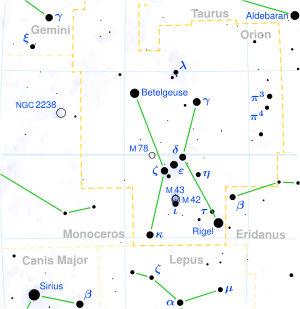Rho Orionis

| |
| Observation data Epoch J2000.0 Equinox J2000.0 | |
|---|---|
| Constellation | Orion |
| Right ascension | 05h 13m 17.48015s[1] |
| Declination | +02° 51′ 40.5479″[1] |
| Apparent magnitude (V) | +4.44[2] |
| Characteristics | |
| Spectral type | K0 III[3] |
| U−B color index | +1.13[2] |
| B−V color index | +1.19[2] |
| Astrometry | |
| Radial velocity (Rv) | 40.5[4] km/s |
| Proper motion (μ) | RA: +0.83[1] mas/yr Dec.: +3.91[1] mas/yr |
| Parallax (π) | 9.32 ± 0.94[1] mas |
| Distance | approx. 350 ly (approx. 110 pc) |
| Absolute magnitude (MV) | −0.65[5] |
| Details[6] | |
| Mass | 2.67 M☉ |
| Luminosity | 251 L☉ |
| Temperature | 4,533 K |
| Age | 650 Myr |
| Orbit[7] | |
| Period (P) | 1031.4 days |
| Semi-major axis (a) | 6.9 mas |
| Eccentricity (e) | 0.1 |
| Inclination (i) | 122.8° |
| Longitude of the node (Ω) | 242.6° |
| Periastron epoch (T) | 2426182.46 |
| Argument of periastron (ω) (secondary) | 17.9° |
| Semi-amplitude (K1) (primary) | 8.70 km/s |
| Other designations | |
| Database references | |
| SIMBAD | data |
Rho Orionis (ρ Ori) is a star in the constellation Orion. Its apparent magnitude is 4.48. Rho Orionis is a single-lined spectroscopic binary with a period of 1031.4 days.[7]
References
- 1 2 3 4 5 van Leeuwen, F. (2007), "Validation of the new Hipparcos reduction", Astronomy and Astrophysics, 474 (2): 653–664, arXiv:0708.1752
 , Bibcode:2007A&A...474..653V, doi:10.1051/0004-6361:20078357.
, Bibcode:2007A&A...474..653V, doi:10.1051/0004-6361:20078357. - 1 2 3 Ducati, J. R. (2002). "VizieR Online Data Catalog: Catalogue of Stellar Photometry in Johnson's 11-color system". CDS/ADC Collection of Electronic Catalogues. 2237. Bibcode:2002yCat.2237....0D.
- ↑ Houk, N.; Swift, C. (1999). "Michigan catalogue of two-dimensional spectral types for the HD Stars, Vol. 5". Michigan Spectral Survey. 05: 0. Bibcode:1999MSS...C05....0H.
- ↑ Famaey, B.; Jorissen, A.; Luri, X.; Mayor, M.; Udry, S.; Dejonghe, H.; Turon, C. (2005). "Local kinematics of K and M giants from CORAVEL/Hipparcos/Tycho-2 data. Revisiting the concept of superclusters". Astronomy and Astrophysics. 430: 165. Bibcode:2005A&A...430..165F. doi:10.1051/0004-6361:20041272.
- ↑ Smith, Graeme H.; Shetrone, Matthew D. (2000). "CaII K Emission-Line Asymmetry among Red Giants Detected by the ROSAT Satellite". The Publications of the Astronomical Society of the Pacific. 112 (776): 1320. Bibcode:2000PASP..112.1320S. doi:10.1086/316634.
- ↑ Luck, R. Earle (2015). "Abundances in the Local Region. I. G and K Giants". The Astronomical Journal. 150 (3): 88. Bibcode:2015AJ....150...88L. doi:10.1088/0004-6256/150/3/88.
- 1 2 Ren, S. (2013), "Hipparcos Photocentric Orbits of 72 Single-lined Spectroscopic Binaries", The Astronomical Journal, 145 (3): 81, Bibcode:2013AJ....145...81R, doi:10.1088/0004-6256/145/3/81
This article is issued from Wikipedia - version of the 11/18/2016. The text is available under the Creative Commons Attribution/Share Alike but additional terms may apply for the media files.